Winston Churchill: Making Art, Making History
“Happy are the painters, for they shall not be lonely. Light and colour, peace and hope, will keep them company to the end, or almost to the end, of the day.”
– Winston Churchill
AVAILABLE ARTWORK
ARTWORK ON LOAN FOR EXHIBITION

SIR WINSTON CHURCHILL, "Distant View of the Pyramids", c. 1921 (C 85)

SIR WINSTON CHURCHILL, "Pointe Bacon, Cap d'Antibes", c. 1933 (C 337)

SIR WINSTON CHURCHILL, "Shadows on the Wall of a Village in the South of France", c. 1930 (C 228)

SIR WINSTON CHURCHILL, "View of Blenheim Palace through the Branches of a Cedar", 1920 (C 269)

SIR WINSTON CHURCHILL, "View of Eze", c. 1930 (C 204)

SIR WINSTON CHURCHILL, "View of Tinherir", 1951 (C 538)
“If it weren’t for painting, I couldn’t bear the strain of things.”
– Winston Churchill
ABOUT
Can we know a person through their work? Can we ever have the full picture? Sir Winston Churchill: Making Art, Making History is a rare opportunity to see the largest collection of paintings by Churchill outside of the United Kingdom, one which has never been exhibited publicly. The general public knows less of Churchill as a painter than as one of the world’s greatest statesmen and Nobel Prize winning writer. His paintings played a critical role in his life, offering another way to understand this towering figure. The exhibition asks us to contemplate the role of painting in his kaleidoscopic life.
“British Prime Minister Winston Churchill speaks with President Franklin D. Roosevelt after their arrival to attend the Yalta Conference”
"Winston Churchill – the young politician – seated at his desk"
“Sir Winston Leonard Spencer Churchill, 1874-1965”
PICTURING CHURCHILL
In 1915, when Winston Churchill was forty, he discovered the pleasures of painting via his neighbors, Hazel Lavery and Glasgow School painter Sir John Lavery, who gave Winston his first lesson. Lady Lavery seized his tentative brush and scolded him as few dared. “Splash into the turpentine wallop into the blue and white, frantic flourish on the palette — clean no longer — and then several large fierce strokes and slashes of blue on the absolute cowering canvas!”
Remember that it was in 1915 that Churchill reached one of his lowest professional points – in the aftermath of the failed Dardanelles campaign, he resigned from government. For the year before he received an appointment as a Lieutenant-Colonel, commanding the 6th Royal Scots Fusiliers, painting became a form of solace and therapy, shifting his focus away from the pressures and stresses of political life. It is the multifaceted nature of Churchill’s life, how he balanced the weight of public leadership and the constant press of his writing output with the personal solace of painting, that intrigues us most. Churchill’s outward life and accomplishments are a spellbinding story, besides which we find the other Winston Churchill, the serious, determined artist, forever seeking a place of solitude that allowed him to paint like a demon. Throwing himself into the act, painting absorbed him and demanded complete concentration. It also offered challenges unbeknownst to him as a writer or public orator. As much as his stirring rhetoric could wield the power to beguile, sway, and turn public opinion, a representational painting stands on its own, stripped of artifice. These paintings connect us to the mind and soul of a singular man engaged pleasurably in his most unguarded moments.
PAINTING AS CRAFT
Churchill took his cues from the Impressionists and Post-Impressionists he admired, and never again did he feel the slightest inhibition in the act of painting. The verve and energy of his early years of painting transitioned to greater mastery as he gained experience. Beginning with an unprimed canvas, Winston learned to work quickly to map out the composition in thinly brushed outlines. He then laid in passages with a broader brush that reflected his learning. “I had hitherto painted the sea flat, with long, smooth strokes of mixed pigment in which the tints varied only by gradations. Now I must try to represent it by innumerable small separate lozenge-shaped points and patches of colour – often pure colour – so that it looked more like a tessellated pavement than a marine picture…”
WHY LANDSCAPES?
The Impressionist influence and his own pleasure most likely made landscapes the genre of choice for Churchill. Painting en plein air (in the open air) was a hallmark for the Impressionists and so too did Churchill haul his paints and canvas outdoors and into nature. Looking at a landscape painting by Churchill is like reading a page of his diary. Each location marked a special place for him.
Take for example Morocco. Churchill’s love affair with Morocco began in the winter of 1935-1936. On the advice of his friend, Sir John Lavery, he chose Marrakech to enjoy the light and scenery. He would return to Morocco several times, each visit colored by his personal enjoyment and thus coloring our understanding of each painting.
Churchill also loved the French Riviera. He enjoyed long holidays along the coast of the South of France. He spent mornings here dictating to his secretary and his afternoons painting. The glorious sunlit seas inspired his sense of color, allowing him to utilize the spectrum of hues from cobalt to cerulean and every Prussian and ultramarine tint between.
But it was not just exotic locations that could inspire Churchill. He would also visit the estates of his friends, such as Lympne, the country home of Philip Sassoon, a political colleague of Churchill’s who also encouraged his artistic efforts. These visits allowed him to bring out his brushes and capture these idyllic visits, moments of calm within his high-pressured political life. Mimizan, where his friend the Duke of Westminster had a house near the Atlantic Coast, was a particular favorite, allowing him the dual attraction of painting and boar hunting.
Still lifes like Oranges and Lemons (C. 455) also give us an insight to the rich and colorful life of Churchill. Churchill painted Oranges and Lemons at La Pausa. Churchill would often frequent La Pausa to visit his literary agent, Emery Reves, who had purchased the home from Coco Chanel. To avoid painting outside on a chilly January morning, Wendy Reves arranged the fruit for Churchill to paint. Surrounded by the Reves’s superb collection of Impressionist and Post-Impressionist works, including a number of paintings by Paul Cézanne, Oranges and Lemons illuminates Churchill’s relationships and the influence of Cézanne, who he admired. The painting, like Churchill, has lived a colorful life, exhibited at both the 1959 Royal Academy of Art exhibition of his paintings and the 1965 New York World’s Fair.
ART, HISTORY, AND ART HISTORY
Winston Churchill painted about 550 works — about half of which were painted between 1930 and 1939 – with new pieces being occasionally discovered. He affectionately called them daubs — only six of which he sold and even then, under a pseudonym. He kept most at his home, Chartwell. Churchill did, however, offer many as gifts, to luminaries as well as staff members and others who helped him. Churchill gave View of Tinherir (C538) as a gift to General George C. Marshall, who Churchill admired for his service as U.S. Army Chief of Staff during World War II. He gave his fellow Nobel Laureate Marshall the gift when Marshall attended Queen Elizabeth II’s coronation as the official U.S. representative.
Studying Churchill and his paintings contextualizes the man, known for his mastery of the word, as a student of paint, who treated his practice seriously. The Royal Academy of Art, founded by luminaries including Thomas Gainsborough, Johann Zoffany, and Angelica Kauffman, bestowed upon Churchill the title “Honorary Academician Extraordinary” in recognition of Churchill’s unique position as an eminent statesman and an accomplished artist. These paintings expand our appreciation for a man who thrived on challenges. Moreover, every artwork by Winston Churchill is an opportunity to step into his mind, to imagine him picking up his brush, to see the same view that he saw, and to interact with a piece of history and culture.
Winston Churchill and his paintings are an area of expertise for Heather James. In 2018, Heather James Fine Art was proud to present an exhibition of ten of Winston Churchill’s works.
7th January 1946 LIFE profile of Winston Churchill
“What is adequacy? Adequacy is no standard at all.”
– Winston Churchill
PRESS
INQUIRY
ADDITIONAL RESOURCES




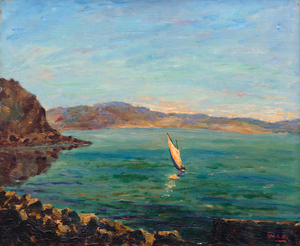
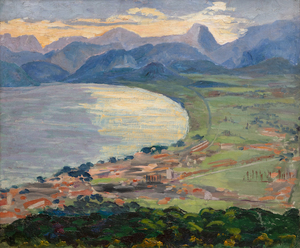
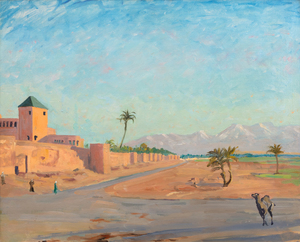
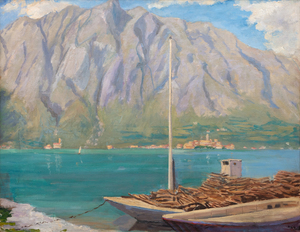
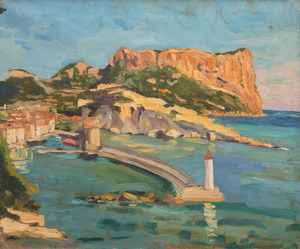
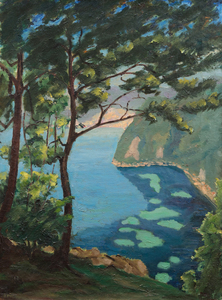
![SIR WINSTON CHURCHILL-View of Loch Choire (C 51) Painted while staying at Dunrobin Castle, the estate of the Duke of Sutherland, Churchill chose to set his easel behind a tree where he likely thought of it as a framing device, adding a layer of depth, creating a stronger sense of foreground, middle ground, and background, enhancing the three-dimensionality of the picture. Churchill painted at both Dunrobin as well as the Duke’s Sutton Place estate, later the home of John Paul Getty.
<br>
<br>As Mary Soames describes it in her book, Winston Churchill, His Life as a Painter, “1921 had been a year of heavy personal tidings” for Churchill and his family, as he lost both his mother, Jennie Cornwallis-West, and his beloved child, Marigold, aged nearly four. In a letter to his wife Clementine, Churchill wrote, “… Many tender thoughts, my darling one of you and yr sweet kittens. Alas I keep on feeling the hurt of the Duckadilly [Marigold’s pet name].” That Churchill chose to stay with the Duke and Duchess at Dunrobin just after Marigold’s death speaks to their close friendship and his fondness for the area, including Loch Choire. It is no surprise that Churchill gifted the painting to the Duke of Sutherland](/Art_Images/Small/TN45743.jpg )
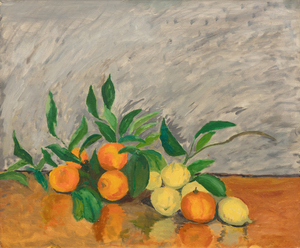
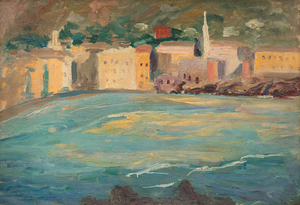
![SIR WINSTON CHURCHILL-The Library of Sir Philip Sassoon's House at Lympne (C 19) Churchill counted as both a friend and political ally, Phillip Sassoon – one of Britain's great hosts, cousin of famed poet Siegfried Sassoon, and the man upon whom Noël Coward crowned "a phenomenon that will never recur”. Sassoon and his sister Sybil were among Winston and Clementine’s great friends. As described by Lady Soames in her book, “Philip Sassoon was a man of charm and distinction, and he dispensed princely hospitality to a brilliant and varied circle of friends at his two country houses, Port Lympne and Trent Park. He made a remarkable collection of works of art. Winston received much help and encouragement from Sassoon, and painted many pictures of both his house and gardens. One of the ways in which Winston taught himself to paint was by copying pictures he admired. With his large and varied collection, Sir Philip was able to be of help in this way, too, and Winston studied and copied quite a number of his friend’s pictures. Sassoon was a friend and patron of John Singer Sargent, and owned many of his works. Winston admired several of these, and found them highly instructive; in 1926, [less than two years before this painting was created] Philip Sassoon wrote Winston this note, which accompanied a generous present and a helpful loan:
<br>
<br>My dear Winston,
<br>
<br>You have often admired the picture of John Lewis Brown of the two horsemen that hung at Trent, so I am sending it to you with my best wishes in the hope that you find a corner for it at Chartwell. I am also sending th little Sargent picture wh you asked for. He painted it when he was 18!”
<br>
<br>One is struck by Sassoon’s generosity, and can see in later works how his close study of Sargent influenced Churchill.](/Art_Images/Small/TN45745.jpg )




















